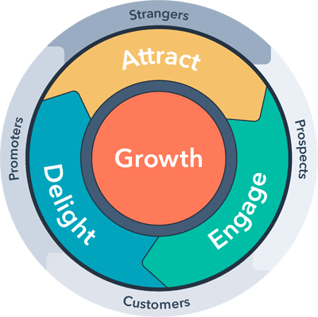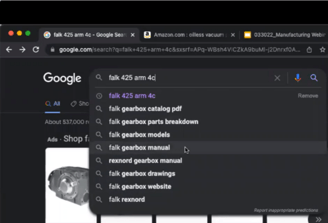Producing content about your products and services is the most effective way to leverage organic search through an inbound marketing strategy (also known as content marketing). People such as engineers and plant managers searching for manufacturing equipment, typically experience a buyer’s journey that includes three phases: awareness, consideration, and decision. To leverage the power of inbound marketing for manufacturing equipment, content should be created or optimized for each of these stages in order to attract, engage and delight customers.
People searching for manufacturing equipment are typically searching with research questions, product questions, or the specific part they are ready to buy. Considering a sales funnel, people searching with research questions are typically at the top of a traditional sales funnel, people searching for products are slightly further in, and when searching for a specific part, they are usually ready to buy. But as users of HubSpot know, rather than a funnel, the inbound methodology more closely resembles a flywheel that is constantly fed when good content is produced to attract, engage and delight prospective customers. (Image Credit: HubSpot)
 Attract Strangers by Answering Search Questions
Attract Strangers by Answering Search Questions
Commonly thought of as the top of the sales funnel, people asking questions on search engines are attracted to your website when it answers questions typed into the search engine. The types of phrasing to help searchers answer their questions:
- Best industrial vacuum pump
- Top-rated industrial meat cutting scissors
- Reduce maintenance problems on CNC router
This is the place to give searchers honest information about the manufacturing equipment you sell. In plain language, list products that are recommended for given situations and why. By helping someone understand what works best for them, a manufacturing marketer builds trust with that person and positions the company as the expert in the field.
Search engines are becoming smarter all the time, so it is important that the page truly answers the questions and provides plenty of information that legitimately helps the reader. If visitors only stay on your page for a few seconds because the answers are not there, it becomes a signal to the search engines that the page is not relevant so the search engine will not consider it as valuable to future searchers so the position on the search engine results page (SERP) drops.
Identify the Best Long-Tail Keywords
Research ways that your target audience asks questions and use their phrasing in the text of the blog post to help your page get ranked at the top of organic search results. Some ways to find out what people ask when looking for answers to their problems:
- Talk to the sales team about how prospective buyers ask them questions
- Ask customer service the specific questions callers ask by phone
- Review your website contact forms to see the way questions are phrased w
 hen someone submits a form
hen someone submits a form - Type the names of your products into a Google search box and see the suggested related searches (some, but not all, will be relevant to your purpose)
Build a content plan around the way prospective customers research your products and ask questions.
Putting yourself in the shoes of your prospective customers and creating content (blog posts or webpages) that are written with these phrases in mind will help search engines find your site and rank on the SERP. And answering customer questions is a proven way to build reputation in your field.
Placement for Targeted Keywords in Content Writing
Phrase your content using the targeted words as naturally as possible within the content of the blog post or webpage. To signify to Google that these words are important place them in the following locations:
- Include the top keyword phrase in the title of the post
- Use other important phrases as subheads and format with H2 tags
- Make keyword text clickable to other related content on your site when fitting
- Include keywords in the meta description and image alt text
Optimizing Ecommerce Pages for SEO
In addition to blog content about your products, your e-commerce product and parts pages play an important role in a content marketing strategy. Taking a cue from the largest e-commerce website, Amazon.com, the more information loaded onto pages, the better a page performs in search results. Include as much information about the product as possible, in an easy to read format on the product pages.
Engage Prospects Performing Product Searches
(for example: oil-less vacuum pump, industrial meat slicer)
For your page to be found when a searcher enters the type of product they want, develop very content-rich product pages that include specs and details about the product, and links to other similar products. Search engines crawl the page and scan the content so the more content-rich the page, the better position it gets on the search engine results page (SERP).
The more often the product details appear on a page on your site, the more weight it is given by the search engines, but it needs to be naturally occurring, not forced. Good product description text, links to similar products, and customer reviews on the product page, the keywords (oil-less, slicer) will naturally be keyword-rich content on the page.
Google recognizes product and parts pages as hub-and-spoke style content, understanding that other similar products are connected, so with quality information and a large amount of content, it is more likely Google will see your site as an authority on the topic and reward you with higher SERP ranking.
Engage Prospects Who are Performing Ecommerce Parts Search
(for example: Caterpillar 290XD tracks, FALK 425 ARM 4C)
When a searcher knows the exact part needed, they want to know the price and when it can be delivered to make a quick transaction. To help them, provide specs and all the information to confirm that this is the exact part they need.
As demonstrated by Amazon, B2B sales sites can include large volumes of content on e-commerces pages after the primary information of part description, image, and price. For example, after the item, description and price, details to list include:
- Customer reviews
- Frequently Asked Questions
- Q&A from the community
- Immense detail about the item (size/dimension specs, compatibility)
Follow the cues of the e-commerce giant and bolster your product and parts pages with as much information as possible since the sites that offer the most information (and competitive price) are more likely to get the sale.
Content on Webpages versus PDFs
While equipment manufacturers often have very detailed PDFs with product specs and dimensions, search engines don't scan PDF pages so the SEO benefit is lost. Include as much spec informational possible on the product webpage because it enhances the richness of your content and provides a better user experience by reducing the number of clicks needed to get information.
The more information you provide in an organized fashion on your website, the better your SEO will be. You won't see overnight results, it takes several months of consistent work. By targeting the right keyword phrases and implementing them onto your website blog and e-commerce pages, you'll build a strong content marketing foundation that can be continually refreshed to continue attracting prospective customers. For further examples and details take a look at our webinar, SEO Tactics that Get Attention from Engineers & Plant Managers or let us know if we can answer your questions.
You may also like:
Digital Marketing for Manufacturers: Playbook for New Product Launches






Agree, disagree, or just have something to add?
Leave a comment below.